|
Size: 7528
Comment: translated a couple of sentences into english, but left names like tiempo to keep the builtin time alone
|
← Revision 36 as of 2020-02-08 13:22:36 ⇥
Size: 19122
Comment:
|
| Deletions are marked like this. | Additions are marked like this. |
| Line 8: | Line 8: |
| {{{ | {{{#!sagecell |
| Line 30: | Line 30: |
| steps_shown = max(nsteps,show_steps) | steps_shown = min(nsteps,show_steps) |
| Line 36: | Line 36: |
| sol_max = max(sol + [find_maximum_on_interval(y_exact,start,stop)[0]]) sol_min = min(sol + [find_minimum_on_interval(y_exact,start,stop)[0]]) show(plot(y_exact(x),start,stop,rgbcolor=(1,0,0))+line([[xvals[index],sol[index]] for index in range(len(sol))]),xmin=start,xmax = stop, ymax = sol_max, ymin = sol_min) |
sol_max = max(sol + [find_local_maximum(y_exact,start,stop)[0]]) sol_min = min(sol + [find_local_minimum(y_exact,start,stop)[0]]) show(plot(y_exact(x),start,stop,rgbcolor=(1,0,0))+line([[xvals[index],sol[index]] for index in range(len(sol))]),xmin=start,xmax = stop, ymax = sol_max, ymin = sol_min) |
| Line 40: | Line 40: |
| table_range = range(len(sol)) | table_range = list(range(len(sol))) |
| Line 42: | Line 42: |
| table_range = range(0,floor(steps_shown/2)) + range(len(sol)-floor(steps_shown/2),len(sol)) html(tab_list([[i,xvals[i],sol[i]] for i in table_range], headers = ['step','x','y'])) |
table_range = list(range(floor(steps_shown/2))) + list(range(len(sol)-floor(steps_shown/2),len(sol))) pretty_print(html(tab_list([[i,xvals[i],sol[i]] for i in table_range], headers = ['step','x','y']))) |
| Line 48: | Line 48: |
| by Mike Hansen (tested and updated by William Stein) {{{ |
by Mike Hansen (tested and updated by William Stein, and later by Dan Drake) {{{#!sagecell |
| Line 51: | Line 51: |
| @interact def _(f = input_box(default=y), g=input_box(default=-x*y+x^3-x), xmin=input_box(default=-1), xmax=input_box(default=1), ymin=input_box(default=-1), ymax=input_box(default=1), start_x=input_box(default=0.5), start_y=input_box(default=0.5), |
from sage.ext.fast_eval import fast_float @interact def _(f = input_box(default=y), g=input_box(default=-x*y+x^3-x), xmin=input_box(default=-1), xmax=input_box(default=1), ymin=input_box(default=-1), ymax=input_box(default=1), start_x=input_box(default=0.5), start_y=input_box(default=0.5), |
| Line 57: | Line 58: |
| old_f = f f = f.function(x,y) old_g = g g = g.function(x,y) |
ff = fast_float(f, 'x', 'y') gg = fast_float(g, 'x', 'y') |
| Line 67: | Line 66: |
| points.append( (xx+step_size*f(xx,yy), yy+step_size*g(xx,yy)) ) | points.append( (xx + step_size * ff(xx,yy), yy + step_size * gg(xx,yy)) ) |
| Line 76: | Line 75: |
| html(r"<h2>$ \frac{dx}{dt} = %s$ $ \frac{dy}{dt} = %s$</h2>"%(latex(old_f),latex(old_g))) print "Step size: %s"%step_size print "Steps: %s"%steps |
pretty_print(html(r"$\displaystyle\frac{dx}{dt} = %s$ $ \displaystyle\frac{dy}{dt} = %s$" % (latex(f),latex(g)))) |
| Line 86: | Line 83: |
| {{{ | {{{#!sagecell |
| Line 92: | Line 89: |
| def _(fin = input_box(default=y+exp(x/10)-1/3*((x-1/2)^2+y^3)*x-x*y^3), gin=input_box(default=x^3-x+1/100*exp(y*x^2+x*y^2)-0.7*x), xmin=input_box(default=-1), xmax=input_box(default=1.8), ymin=input_box(default=-1.3), ymax=input_box(default=1.5), x_start=(-1,(-2,2)), y_start=(0,(-2,2)), error=(0.5,(0,1)), |
def _(fin = input_box(default=y+exp(x/10)-1/3*((x-1/2)^2+y^3)*x-x*y^3), gin=input_box(default=x^3-x+1/100*exp(y*x^2+x*y^2)-0.7*x), xmin=input_box(default=-1), xmax=input_box(default=1.8), ymin=input_box(default=-1.3), ymax=input_box(default=1.5), x_start=(-1,(-2,2)), y_start=(0,(-2,2)), error=(0.5,(0,1)), |
| Line 109: | Line 106: |
| g(x,y)=gin |
g(x,y)=gin |
| Line 113: | Line 110: |
| Line 115: | Line 112: |
| path = [] | path = [] |
| Line 121: | Line 118: |
| T.function = lambda t, yp: [ff(yp[0],yp[1]), gg(yp[0],yp[1])] | T.function = lambda t, yp: [ff(yp[0],yp[1]), gg(yp[0],yp[1])] |
| Line 133: | Line 130: |
| == Linear two-dimensional ODEs == by Marshall Hampton {{{ %cython cpdef c_euler_m(double t0, double x10, double x20, double tend, int steps, double a11, double a12, double a21, double a22, double cutoff = 10): cdef double h = (tend-t0)/steps traj = [[x10,x20]] cdef double x1current = x10 cdef double x2current = x20 cdef int i cdef double newx1 cdef double newx2 for i in range(0,steps): newx1 = x1current + h*a11*x1current + h*a12*x2current newx2 = x2current + h*a21*x1current + h*a22*x2current if newx1 > cutoff or newx2 > cutoff or newx1 < -cutoff or newx2 < -cutoff: break traj.append([newx1,newx2]) x1current = newx1 x2current = newx2 return traj }}} {{{ @interact def planarsystem(a11 = slider(srange(-10,10,1/10),default = -1), a12 = slider(srange(-10,10,1/10),default = -1), a21 = slider(srange(-10,10,1/10),default = 1), a22 = slider(srange(-10,10,1/10),default = -1), time_tracked = slider(srange(1,100,1.0),default=10)): A = matrix(RDF,[[a11,a12],[a21,a22]]) eigs = A.eigenvalues() pretty_print(html('<center>$x\' = Ax$ dynamics<BR>$A = '+latex(A)+'$, eigenvalues: $%2.2f + %2.2fI, %2.2f + %2.2fI$</center>'%(eigs[0].real(),eigs[0].imag(),eigs[1].real(),eigs[1].imag()))) trajs = Graphics() for q in srange(0,2*pi,.15): astart = randint(1,10) ntraj = c_euler_m(0,cos(q),sin(q),time_tracked,300,a11,a12,a21,a22) for i in range(astart,len(ntraj)-1,10): trajs = trajs + arrow(ntraj[i],ntraj[i+1],width=1, arrowsize=2) trajs = trajs + line(ntraj) ntraj = c_euler_m(0,cos(q),sin(q),-time_tracked,300,a11,a12,a21,a22) trajs = trajs + line(ntraj) for i in range(astart,len(ntraj)-1,10): trajs = trajs + arrow(ntraj[i+1],ntraj[i],width=1, arrowsize=2) show(trajs, figsize = [6,6], xmin = -1, xmax = 1, ymin = -1, ymax = 1) }}} {{attachment:linear2x2.png}} == Euler's Method, Improved Euler, and 4th order Runge-Kutta in one variable == by Marshall Hampton. This is a more baroque version of the Euler's method demo above. {{{#!sagecell def ImpEulerMethod(xstart, ystart, xfinish, nsteps, f): sol = [ystart] xvals = [xstart] h = N((xfinish-xstart)/nsteps) for step in range(nsteps): k1 = f(xvals[-1],sol[-1]) k2 = f(xvals[-1] + h,sol[-1] + k1*h) sol.append(sol[-1] + h*(k1+k2)/2) xvals.append(xvals[-1] + h) return list(zip(xvals,sol)) def RK4Method(xstart, ystart, xfinish, nsteps, f): sol = [ystart] xvals = [xstart] h = N((xfinish-xstart)/nsteps) for step in range(nsteps): k1 = f(xvals[-1],sol[-1]) k2 = f(xvals[-1] + h/2,sol[-1] + k1*h/2) k3 = f(xvals[-1] + h/2,sol[-1] + k2*h/2) k4 = f(xvals[-1] + h,sol[-1] + k3*h) sol.append(sol[-1] + h*(k1+2*k2+2*k3+k4)/6) xvals.append(xvals[-1] + h) return list(zip(xvals,sol)) def tab_list(y, headers = None): ''' Converts a list into an html table with borders. ''' s = '<table border = 1>' if headers: for q in headers: s = s + '<th>' + str(q) + '</th>' for x in y: s = s + '<tr>' for q in x: s = s + '<td>' + str(q) + '</td>' s = s + '</tr>' s = s + '</table>' return s var('x, y') @interact def euler_method(q = range_slider(0,10,.1,(0,6),'x range'), y_exact_in = input_box('-cos(x)+2.0', type = str, label = 'Exact solution = '), y_prime_in = input_box('sin(x)', type = str, label = "y' = "), startval = input_box(1.0, label = 'Starting value for y: '), nsteps = slider([2^m for m in range(0,10)], default = 10, label = 'Number of steps: '), show_steps = slider([2^m for m in range(0,10)], default = 8, label = 'Number of steps shown in table: ')): start = q[0] stop = q[1] y_exact = lambda x: eval(y_exact_in) y_prime = lambda x,y: eval(y_prime_in) stepsize = float((stop-start)/nsteps) steps_shown = min(nsteps,show_steps) sol2 = ImpEulerMethod(start, startval, stop, nsteps, y_prime) sol3 = RK4Method(start, startval, stop, nsteps, y_prime) sol = [startval] xvals = [start] for step in range(nsteps): sol.append(sol[-1] + stepsize*y_prime(xvals[-1],sol[-1])) xvals.append(xvals[-1] + stepsize) sol_max = max(sol + [find_local_maximum(y_exact,start,stop)[0]]) sol_min = min(sol + [find_local_minimum(y_exact,start,stop)[0]]) slopes = plot_slope_field(y_prime(x=x,y=y), (start,stop), (sol_min, sol_max)) exact_plot = plot(y_exact(x),start,stop,rgbcolor=(1,0,0)) euler_plot = line([[xvals[index],sol[index]] for index in range(len(sol))]) rk4_plot = line(sol3, rgbcolor = (0,0,.125)) imp_plot = line(sol2, rgbcolor = (1,0,1)) show(slopes +exact_plot + euler_plot + imp_plot+ rk4_plot,xmin=start,xmax = stop, ymax = sol_max, ymin = sol_min) if nsteps < steps_shown: table_range = list(range(len(sol))) else: table_range = list(range(floor(steps_shown/2))) + list(range(len(sol)-floor(steps_shown/2),len(sol))) html(tab_list([[i,xvals[i],sol[i],sol2[i][1],sol3[i][1],y_exact(xvals[i])] for i in table_range], headers = ['step','x','<font color="#0000FF">Euler</font>','<font color="#FF00FF">Imp. Euler</font>', '<font color="#0000bb">RK4</font>','<font color="#FF0000">Exact</font>'])) }}} {{attachment:rk4.png}} |
|
| Line 141: | Line 253: |
| == Picard iteration example == by Marshall Hampton and David Joyner {{{#!sagecell def picard_iteration(f, a, c, iterations): r''' Computes the N-th Picard iterate for the IVP x' = f(t,x), x(a) = c. EXAMPLES:: sage: var('x t s') (x, t, s) sage: a = 0; c = 2 sage: f = lambda t,x: 1-x sage: picard_iteration(f, a, c, 0) 2 sage: picard_iteration(f, a, c, 1) 2 - t sage: picard_iteration(f, a, c, 2) t^2/2 - t + 2 sage: picard_iteration(f, a, c, 3) -t^3/6 + t^2/2 - t + 2 ''' if iterations == 0: return c if iterations == 1: x0 = lambda t: c + integral(f(t=s,x=c), s, a, t) return expand(x0(t)) for i in range(iterations): x_old = lambda s: picard_iteration(f, a, c, iterations-1).subs(t=s) x0 = lambda t: c + integral(f(t=s,x=x_old(s)), s, a, t) return expand(x0(t)) @interact def picarder(n_iterations = slider(0,20,1,default = 2)): var('x,t,s') f = lambda t,x:x html(r"Exact solution to $x' = x$, $x(0) = 1$ is $x = \exp(t)$<br>") pic = picard_iteration(f,0,1,n_iterations) html('The Picard iteration approximation after ' + str(n_iterations) + ' iterations is:<br>') html('$'+latex(pic)+'$') exact = plot(exp(t),(t,0,2)) pic_plot = plot(pic,(t,0,2), rgbcolor = (1,0,0)) show(exact + pic_plot) }}} {{attachment:picard.png}} == Euler-Maruyama method and geometric Brownian motion (a common simple model of the stock market) == by Marshall Hampton {{{#!sagecell def EulerMaruyama(xstart, ystart, xfinish, nsteps, f1, f2): sol = [ystart] xvals = [xstart] h = N((xfinish-xstart)/nsteps) for step in range(nsteps): sol.append(sol[-1] + h*f1(sol[-1]) + h^(.5)*f2(sol[-1])*normalvariate(0,1)) xvals.append(xvals[-1] + h) return list(zip(xvals,sol)) out = Graphics() save(out,'temp') @interact def EulerMaruyamaExample(mu = slider(srange(0,10,.1),default=2.0), sigma = slider(srange(0,10,.1),default=0.5), plots_at_a_time = slider(range(1,100),default=10), number_of_steps = slider(range(1,1000),default=100), clear_plot = checkbox(True), auto_update=False): html('<center>Example of the Euler-Maruyama method applied to<br>the stochastic differential equation for geometric Brownian motion</center>') html(r'<center>$S = S_0 + \int_0^t \mu S dt + \int_0^t \sigma S dW$</center>') emplot = list_plot(EulerMaruyama(0,1,1,number_of_steps,lambda x: mu*x,lambda x:sigma*x),plotjoined=True) for i in range(1,plots_at_a_time): emplot = emplot + list_plot(EulerMaruyama(0,1,1,100,lambda x: mu*x,lambda x:sigma*x),plotjoined=True) if clear_plot: out = emplot save(out,'temp') else: out = load('temp') out = out + emplot save(out,'temp') show(out, figsize = [8,5]) }}} {{attachment:eulermaruyama.png}} == Autonomous equations and stable/unstable fixed points == by Marshall Hampton This needs the Cython functon defined in a seperate cell. Note that it is not a particularly good example of Cython use. {{{ %cython cpdef RK4_1d(f, double t_start, double y_start, double t_end, int steps, double y_upper = 10**6, double y_lower = -10**6): ''' Fourth-order scalar Runge-Kutta solver with fixed time steps. f must be a function of t,y, where y is just a scalar variable. ''' cdef double step_size = (t_end - t_start)/steps cdef double t_current = t_start cdef double y_current = y_start cdef list answer_table = [] cdef int j answer_table.append([t_current,y_current]) for j in range(0,steps): k1=f(t_current, y_current) k2=f(t_current+step_size/2, y_current + k1*step_size/2) k3=f(t_current+step_size/2, y_current + k2*step_size/2) k4=f(t_current+step_size, y_current + k3*step_size) t_current += step_size y_current = y_current + (step_size/6)*(k1+2*k2+2*k3+k4) if y_current > y_upper or y_current < y_lower: j = steps answer_table.append([t_current,y_current]) return answer_table }}} {{{ from sage.rings.polynomial.real_roots import * var('x') @interact def autonomous_plot(poly=input_box(x*(x-1)*(x-2),label='polynomial'), t_end = slider(1,10,step_size = .1)): var('x') y = polygen(ZZ) ypoly = sage_eval(repr(poly).replace('x','y'),locals=locals()) rr = real_roots(ypoly, max_diameter = 1/100) eps = 0.2 delvals = .04 minr = min([x[0][0] for x in rr]) maxr = max([x[0][1] for x in rr]) svals = [(minr-eps)*t+(1-t)*(maxr+eps) for t in srange(0,1+delvals,delvals)] def polyf(t,xi): return poly(x=xi) paths = [RK4_1d(polyf,0.0,q,t_end,100.0) for q in svals] miny = max(minr-eps,min([min([q1[1] for q1 in q]) for q in paths])) maxy = min(maxr+eps,max([max([q1[1] for q1 in q]) for q in paths])) solpaths = sum([line(q) for q in paths]) fixedpoints = sum([line([[0,(q[0][0]+q[0][1])/2],[t_end,(q[0][0]+q[0][1])/2]], rgbcolor = (1,0,0)) for q in rr]) var('t') html("Autonomous differential equation $x' = p(x)$") show(solpaths+fixedpoints, ymin = miny, ymax = maxy, xmin = 0, xmax = t_end, figsize = [6,4]) }}} {{attachment:Autonomous1.png}} |
|
| Line 144: | Line 398: |
| {{{ | {{{#!sagecell |
| Line 152: | Line 406: |
| alpha=[(n,c*numerical_integral(f(x)*sin(x*n/2),0,2*pi)[0] ) for n in range(1,orden)] | alpha=[(n,c*numerical_integral(f*sin(x*n/2),0,2*pi)[0] ) for n in range(1,orden)] |
| Line 162: | Line 416: |
| == Heat equation using finite diferences in cython (very fast!) == | == Heat equation using finite diferences in cython == |
| Line 186: | Line 440: |
| def _(f=input_box(default=x*exp(-x^2)), longitud=input_box(default=2*pi), | def _(f=input_box(default=x*exp(-x^2),label='f(x)'), longitud=input_box(default=2*pi), |
| Line 189: | Line 443: |
| efe=f._fast_float_() | efe=f._fast_float_(x) |
| Line 193: | Line 447: |
| Line 196: | Line 450: |
| print 's=%f > 1/2!!! The method is not stable'%s |
print('s=%f > 1/2!!! The method is not stable' % s) |
| Line 199: | Line 453: |
| show( line2d(zip(xs, u0)) + line2d(zip(xs, ut), rgbcolor='green') ) | show( line2d(list(zip(xs, u0))) + line2d(list(zip(xs, ut)), rgbcolor='green') ) |
| Line 203: | Line 457: |
== DE with boundary values == The following interact demo looks at the DE+BC y'+y=0, y(0)=a, y(b)=c, and has a slider for b. When b=pi "problems arise":-) {{{#!sagecell var('x') @interact def BCs(b=input_box(1,label='BC at far endpoint'), c = slider(1,5,step_size = .01), a = 1): P1 = text(r"$y''+y=0,\ y(0) = a,\ y(b) = c$",(4,-1/(c-3.14152))) P2 = plot(a*cos(x)+(b-a*cos(c))*sin(x)/sin(c),x,0,5) (P1+P2).show() }}} [[attachment:de-interact-with-BCs.sws]] |
Sage Interactions - Differential Equations
goto interact main page
Contents
-
Sage Interactions - Differential Equations
- Euler's Method in one variable
- Vector Fields and Euler's Method
- Vector Field with Runga-Kutta-Fehlberg
- Linear two-dimensional ODEs
- Euler's Method, Improved Euler, and 4th order Runge-Kutta in one variable
- Mass/Spring systems
- Picard iteration example
- Euler-Maruyama method and geometric Brownian motion (a common simple model of the stock market)
- Autonomous equations and stable/unstable fixed points
- Heat equation using Fourier series
- Heat equation using finite diferences in cython
- DE with boundary values
Euler's Method in one variable
by Marshall Hampton. This needs some polishing but its usable as is.
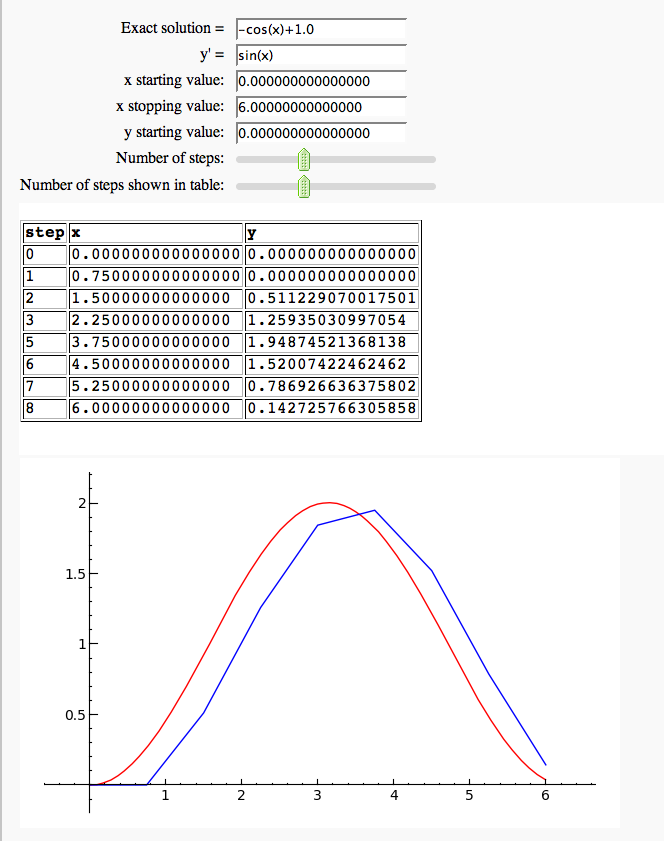
Vector Fields and Euler's Method
by Mike Hansen (tested and updated by William Stein, and later by Dan Drake)
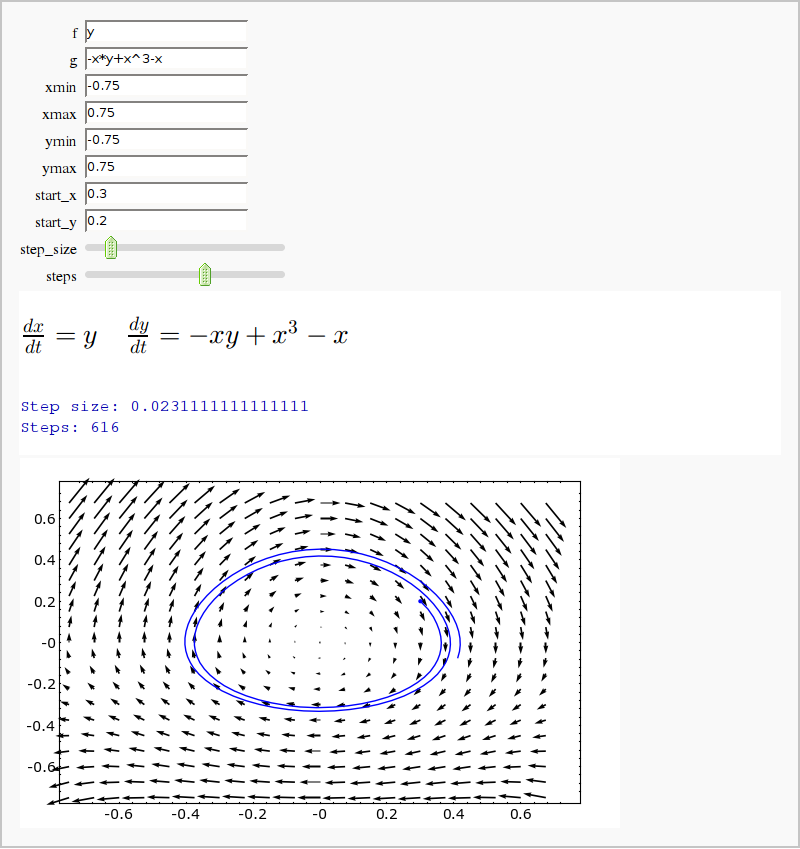
Vector Field with Runga-Kutta-Fehlberg
by Harald Schilly
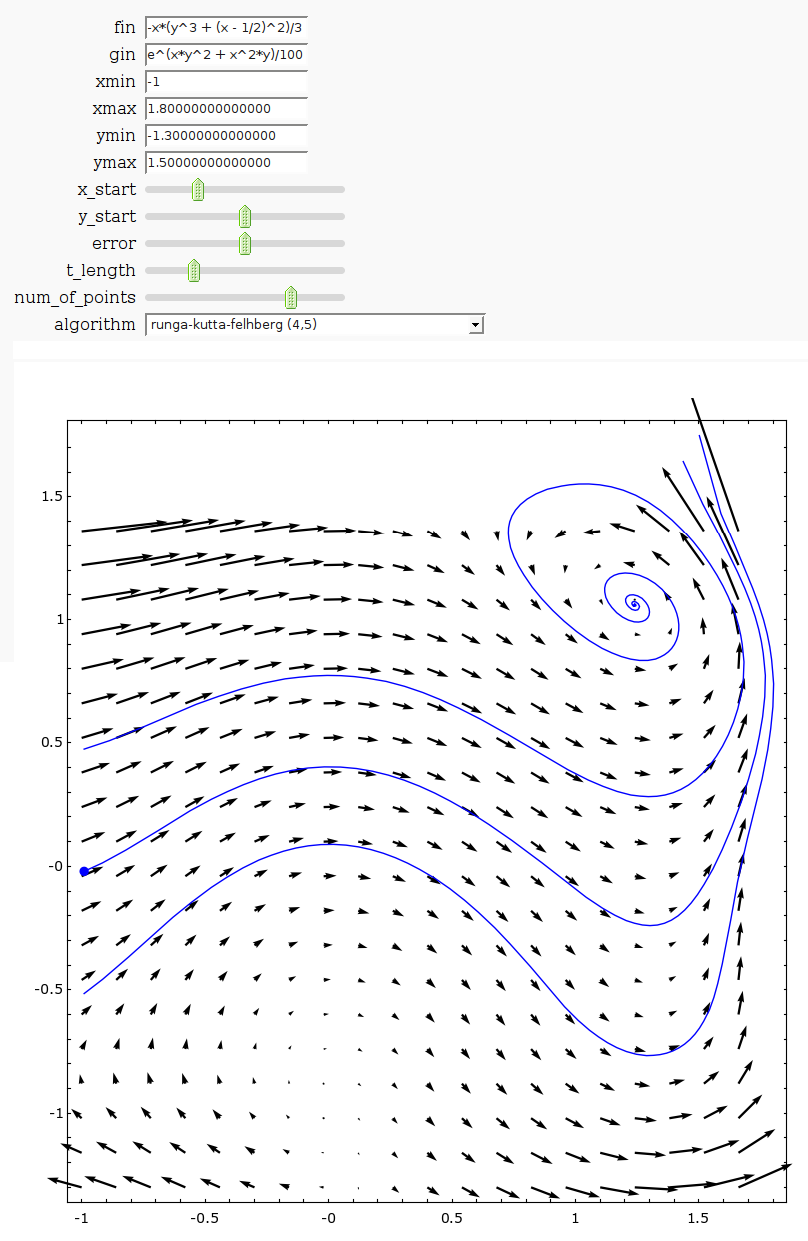
Linear two-dimensional ODEs
by Marshall Hampton
%cython
cpdef c_euler_m(double t0, double x10, double x20, double tend, int steps, double a11, double a12, double a21, double a22, double cutoff = 10):
cdef double h = (tend-t0)/steps
traj = [[x10,x20]]
cdef double x1current = x10
cdef double x2current = x20
cdef int i
cdef double newx1
cdef double newx2
for i in range(0,steps):
newx1 = x1current + h*a11*x1current + h*a12*x2current
newx2 = x2current + h*a21*x1current + h*a22*x2current
if newx1 > cutoff or newx2 > cutoff or newx1 < -cutoff or newx2 < -cutoff:
break
traj.append([newx1,newx2])
x1current = newx1
x2current = newx2
return traj@interact
def planarsystem(a11 = slider(srange(-10,10,1/10),default = -1), a12 = slider(srange(-10,10,1/10),default = -1), a21 = slider(srange(-10,10,1/10),default = 1), a22 = slider(srange(-10,10,1/10),default = -1), time_tracked = slider(srange(1,100,1.0),default=10)):
A = matrix(RDF,[[a11,a12],[a21,a22]])
eigs = A.eigenvalues()
pretty_print(html('<center>$x\' = Ax$ dynamics<BR>$A = '+latex(A)+'$, eigenvalues: $%2.2f + %2.2fI, %2.2f + %2.2fI$</center>'%(eigs[0].real(),eigs[0].imag(),eigs[1].real(),eigs[1].imag())))
trajs = Graphics()
for q in srange(0,2*pi,.15):
astart = randint(1,10)
ntraj = c_euler_m(0,cos(q),sin(q),time_tracked,300,a11,a12,a21,a22)
for i in range(astart,len(ntraj)-1,10):
trajs = trajs + arrow(ntraj[i],ntraj[i+1],width=1, arrowsize=2)
trajs = trajs + line(ntraj)
ntraj = c_euler_m(0,cos(q),sin(q),-time_tracked,300,a11,a12,a21,a22)
trajs = trajs + line(ntraj)
for i in range(astart,len(ntraj)-1,10):
trajs = trajs + arrow(ntraj[i+1],ntraj[i],width=1, arrowsize=2)
show(trajs, figsize = [6,6], xmin = -1, xmax = 1, ymin = -1, ymax = 1)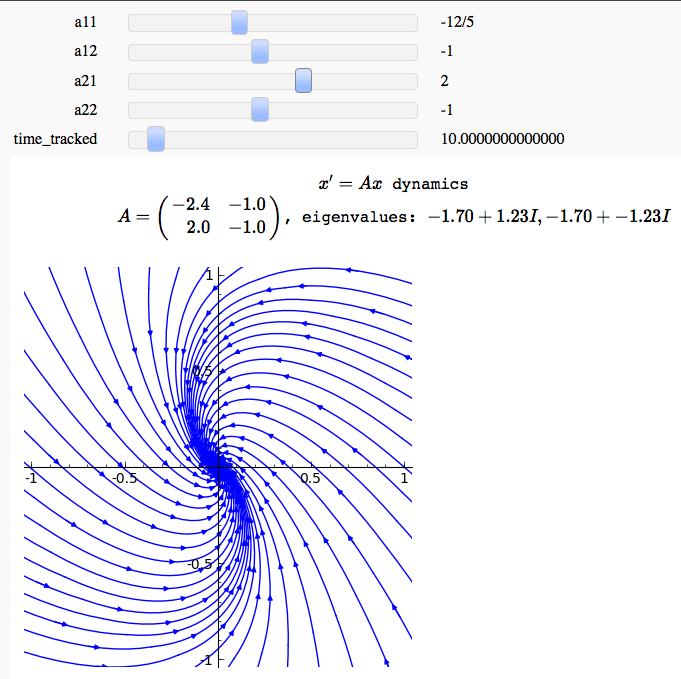
Euler's Method, Improved Euler, and 4th order Runge-Kutta in one variable
by Marshall Hampton. This is a more baroque version of the Euler's method demo above.

Mass/Spring systems
by Jason Grout
These two interacts involve some Cython code or other scipy imports, so I've posted a file containing them. You can download the worksheet or copy it online.
Picard iteration example
by Marshall Hampton and David Joyner
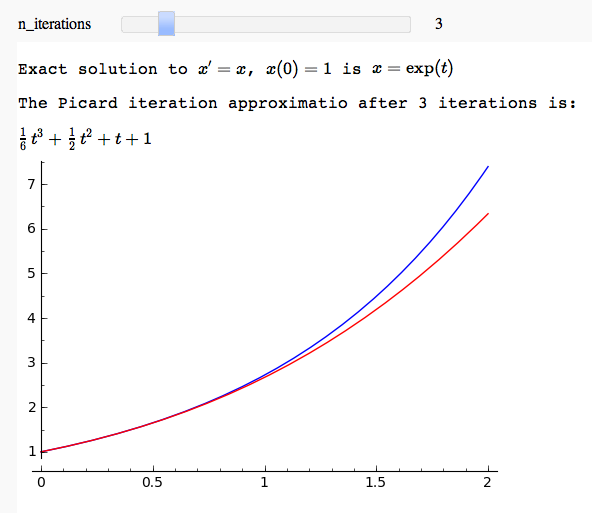
Euler-Maruyama method and geometric Brownian motion (a common simple model of the stock market)
by Marshall Hampton
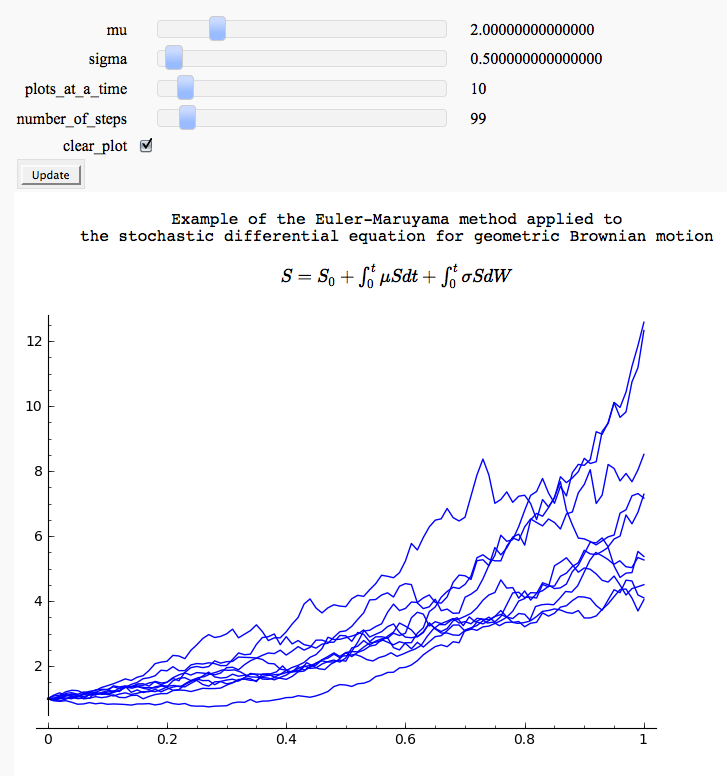
Autonomous equations and stable/unstable fixed points
by Marshall Hampton This needs the Cython functon defined in a seperate cell. Note that it is not a particularly good example of Cython use.
%cython
cpdef RK4_1d(f, double t_start, double y_start, double t_end, int steps, double y_upper = 10**6, double y_lower = -10**6):
'''
Fourth-order scalar Runge-Kutta solver with fixed time steps. f must be a function of t,y,
where y is just a scalar variable.
'''
cdef double step_size = (t_end - t_start)/steps
cdef double t_current = t_start
cdef double y_current = y_start
cdef list answer_table = []
cdef int j
answer_table.append([t_current,y_current])
for j in range(0,steps):
k1=f(t_current, y_current)
k2=f(t_current+step_size/2, y_current + k1*step_size/2)
k3=f(t_current+step_size/2, y_current + k2*step_size/2)
k4=f(t_current+step_size, y_current + k3*step_size)
t_current += step_size
y_current = y_current + (step_size/6)*(k1+2*k2+2*k3+k4)
if y_current > y_upper or y_current < y_lower:
j = steps
answer_table.append([t_current,y_current])
return answer_tablefrom sage.rings.polynomial.real_roots import *
var('x')
@interact
def autonomous_plot(poly=input_box(x*(x-1)*(x-2),label='polynomial'), t_end = slider(1,10,step_size = .1)):
var('x')
y = polygen(ZZ)
ypoly = sage_eval(repr(poly).replace('x','y'),locals=locals())
rr = real_roots(ypoly, max_diameter = 1/100)
eps = 0.2
delvals = .04
minr = min([x[0][0] for x in rr])
maxr = max([x[0][1] for x in rr])
svals = [(minr-eps)*t+(1-t)*(maxr+eps) for t in srange(0,1+delvals,delvals)]
def polyf(t,xi):
return poly(x=xi)
paths = [RK4_1d(polyf,0.0,q,t_end,100.0) for q in svals]
miny = max(minr-eps,min([min([q1[1] for q1 in q]) for q in paths]))
maxy = min(maxr+eps,max([max([q1[1] for q1 in q]) for q in paths]))
solpaths = sum([line(q) for q in paths])
fixedpoints = sum([line([[0,(q[0][0]+q[0][1])/2],[t_end,(q[0][0]+q[0][1])/2]], rgbcolor = (1,0,0)) for q in rr])
var('t')
html("Autonomous differential equation $x' = p(x)$")
show(solpaths+fixedpoints, ymin = miny, ymax = maxy, xmin = 0, xmax = t_end, figsize = [6,4])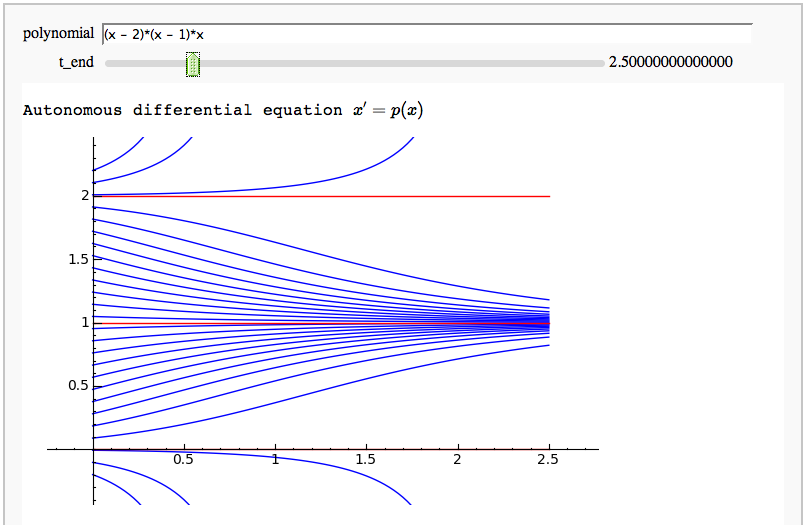
Heat equation using Fourier series
by Pablo Angulo
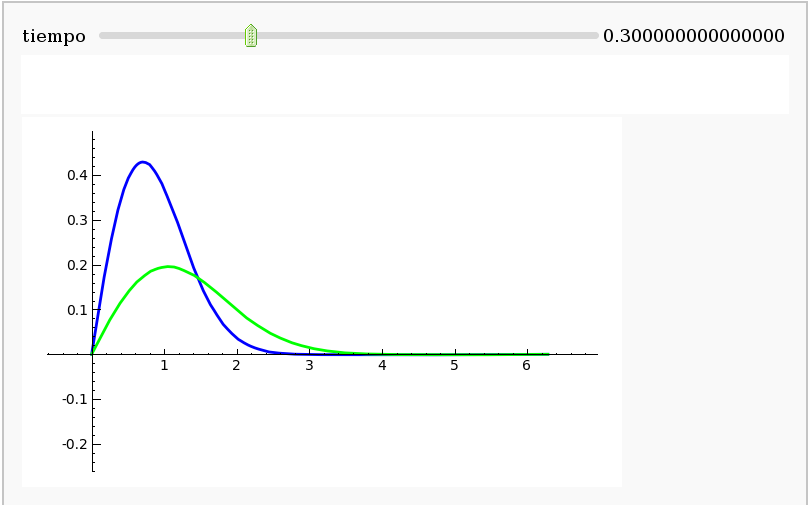
Heat equation using finite diferences in cython
by Pablo Angulo
%cython
#cython code implementing a very simple finite diference scheme
import numpy as np
def calor_cython(u0,float dx, float k,float t_f,int tsteps):
cdef int m
cdef float dt
cdef float s
u=np.array(u0)
dt=t_f/tsteps
s=k*dt/(dx**2) #we cannot use ^ for exponentiation in cython
for m in range(tsteps):
u[1:-1]=(1-2*s)*u[1:-1]+s*u[0:-2]+s*u[2:]
return u#interact box wrapping the code above
var('x')
@interact
def _(f=input_box(default=x*exp(-x^2),label='f(x)'), longitud=input_box(default=2*pi),
tiempo=input_box(default=0.1), M=input_box(default=100),
k=input_box(default=1), tsteps=input_box(default=2000) ):
efe=f._fast_float_(x)
dx=float(longitud/M)
xs=[n*dx for n in range(M+1)]
u0=[efe(a) for a in xs]
s=k*(tiempo/tsteps) /dx^2
if s>0.5:
print('s=%f > 1/2!!! The method is not stable' % s)
ut=calor_cython(u0,dx,k,tiempo,tsteps)
show( line2d(list(zip(xs, u0))) + line2d(list(zip(xs, ut)), rgbcolor='green') )
DE with boundary values
The following interact demo looks at the DE+BC y'+y=0, y(0)=a, y(b)=c, and has a slider for b. When b=pi "problems arise":-)
